#Grape Cultivation Types
Explore tagged Tumblr posts
Text
I get a little annoyed at how writings don't give Native North American peoples any agency in agricultural technologies
Domestication takes hundreds or thousands of years to accomplish, so it's weird to me that so many sources claim that food plants native to North America were cultivated into existence after European settlement, from a "wild" ancestor into a highly desirable crop
Take for example, the famous Concord grape. Supposedly it was bred from wild ancestors in a few years by just one guy.
With pecans, the word itself is Algonquin, so it's harder to deny that Native Americans cultivated them, but supposedly "domestication began in the 1800's". and as the source says, "wild-type" pecans are perfectly acceptable for sale in the market
And then there is nonsense like all the sources that will tell you pawpaws are an "evolutionary anachronism" from when they were distributed by giant ground sloths and other megafauna, as though humans don't count.
Are we to believe that indigenous peoples knew nothing of plant breeding? When the Cherokee were given peaches, apples, and watermelon, they adopted the new plants for use in their orchards and soon developed their own breeds.
Don't even get me started on all the plants that were almost lost and largely not used anymore, like Rivercane and the American Chestnut.
2K notes
·
View notes
Text
How Umemiya Hajime Loves | As Told By Tarot
cw. gn!reader, tarot, headcanons pairing. umemiya x reader notes. normally, i stop at 4 cards per character but i've been thinking about doing more lengthy, in-depth readings with multiple stacks lately. so i figured, why not give this a shot with my newest obsession? if you have any characters you want me to cover, let a girl know deck. prisma visions tarot & true black tarot
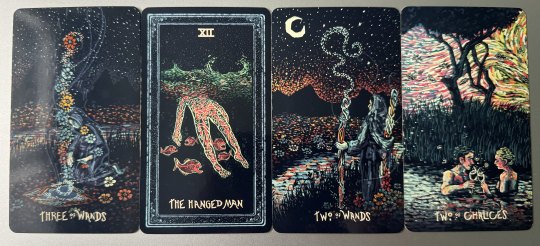
three of wands, the hanged man, two of wands, two of chalices
When Umemiya Hajime falls, he falls. There's no resisting the waves as it envelops his person; instead he allows himself to be full submerged. He allows you to see him for who he is, all that he has been and all he will be and you allow him to do the same. You're his person. Hajime loves everyone he calls family and treats them all kindly but even among them you are special. The moment you are someone he sees he has a future with, he works towards that future little by little through connecting with you and cultivating a love that will last indefinitely. He isn't the type to seek short-term relationships, Umemiya Hajime wants forever.
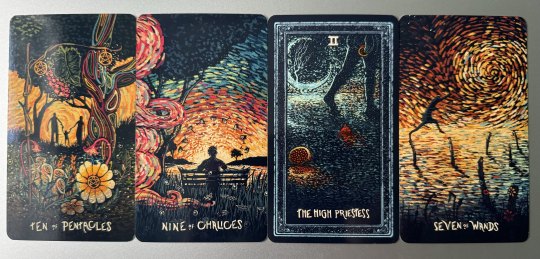
ten of pentacles, nine of chalices, the high priestess, seven of wands
It should also be no surprise that he wants a large family. How this family is ultimately is obtained is of little importance to him but he wants a family. Kid running through the house to wake you both up to watch whatever their favorite morning cartoon is, little fingers covered in pancake batter as his little helper valiantly helps him make breakfast, the whole nine yards. That future is a dream come true for him who has always wanted a family of his own. Of course he is aware it takes hard work to get to that future let alone maintain it, but he is prepared for that challenge. Hajime is someone who thrives in large groups but for him to really be happy, you have to be happy as well. He's great at reading you and piecing together what you want but he isn't a mind reader, tell him what you want and need and he'll always be happy to reach a compromise where you are both satisfied.

the emperor, three of pentacles, the lovers, two of pentacles
Rather than constantly go back and forth fixing a leak to push his town in the right direction, Hajime decided to rebuild the entire house and relay the foundation brick by brick. He approaches self-improvement and relationships in the same manner. Words aren't enough, you need action to back them up. His actions more than speak for themself. You know he loves you in the things he does grand and small. He goes above and beyond to make sure you never have to question how he feels. Hajime fights that much harder when something he loves is on the line. Love is the very source of his strength. A joyous feeling that cloaks the two of you in a freeing dance of self-expression and intimacy reserved solely for the two of you. Together the food tastes that much better, the drinks that much flavorful and the hues of the world that much more vibrant. He wants you to feel the same way when you're with him.
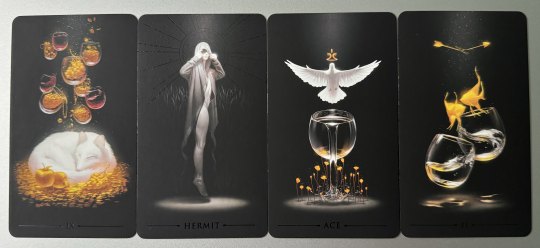
nine of cups, the hermit, ace of cups, two of cups
For Hajime, this love feels like a luxury. Both of your glasses will always be full, overflowing with wine that he has grown with grapes from his very own garden. His pockets may not be overflowing in gold but if one could be paid in emotional wealth, Hajime is richer than the greatest king. It has taken much introspection to become the man he become today. A lot of pain he has had to overcome. Yet despite that pain, like how the scarred dove continues to fly so does Umemiya Hajime. His love continues to flow and pour onto the garden that is his relationship with you, carefully cultivating a living mosaic that encompasses your relationship. War and disruption does not exist in this man, thus it does not exist in your relationship. There is only peace and harmony bathed in a soft glow. Yours is a relationship that continues this soft dance for as long as time allows.
#look she's writing#headcanons#tarot#windbreaker#wind breaker#hajime umemiya#umemiya hajime#umemiya x reader#umemiya hajime x reader
120 notes
·
View notes
Text
Let's Talk About Sages
(Please note that the purpose of this post is not to encourage people to participate in closed practices, but to learn about the sage family of plants in order for others to forge their own practices.)
White sage gets a lot of attention in spiritual and witchy spaces, for good reason, but I feel like people forget how many different types of sage there are. You don't need white sage when there are so many other beautiful sages local to different parts of the world, and is cultivated commonly in plant nurseries.
Sage is insanely easy to come by in the spring either as seed packets or as live plants in nurseries. It just hides under a different name.
Salvia!
Salvia is the genus name for sage. For example, white sage is Salvia apiana.
Lets look at another sage, the mealycup sage, Salvia farinacea.

Mealycup sage is a fantastic plant to add to your garden, not only does it smell wonderful, but it attracts so much wildlife. Bees, butterflies and hummingbirds are attracted to the nectar in the spring and summer and in the fall finches eat the seeds.
I planted this sage outside my bedroom window for spiritual protection, mental balance, and wisdom, pulling that magic from the color of the flowers and the lore revolving around sage in general. I feel that it works fantastically.
A sage that is harder to come across is azure sage, Salvia azurea.

Another pollinator friendly plant found throughout most of the US and can be acquired in native plant nurseries. This plant is great in permaculture plots and is a perennial. Buy it once and you could work with it for a lifetime!
And who can forget about Salvia officinalis, garden sage!

Add the power of this helpful plant to your food and teas with this great plant with it's strong earthy flavor!
Other amazing sages include:
Mexican Bush Sage - Salvia leucantha
Musk Sage - Salvia clevelandii
Pineapple Sage - Salvia elegans
Grape Sage - Salvia melissordora
Clary Sage - Salvia sclarea
Fruit Sage - Salvia dorisiana
Chia seeds are even a sage!!! Saliva hispanica/ Saliva columbariae!
Long story short; there are 1000 species of sage. Find one that calls to you, learn about it, plant it, and work with it.
22 notes
·
View notes
Note
Crowley not so subtly begging Papa Asim for donations :3c
Ah, yes 😌 A tale as old as time… Nobody let Jamil overhear this—
Family means Nobody is Left Behind or Forgotten.

“Night Raven College is greatly honored by your presence, Mr. Asim!!” Crowley warbled as he flitted around his desk, wine bottle in hand, and right up to his guest. "Please, allow me to pour you a drink!"
Mr. Asim and Kalim were seated in luxurious chairs (something Crowley had specially procured for this occasion), cushions silken and stuffed with the down of baby birds. The businessman was draped in the finest fabrics with expect stitching, brilliant peacock greens, blues, and golds bright against his white hair and rich skin.
He beamed—his smile so much like that of his son—and held up his glass in a hand heavy with sparkling gems. "Most hospitable of you, headmaster. I'll have just a nip, thank you."
"My pleasure!!" Crowley purred, tipping the bottle over. A stream of deep garnet liquid filled Mr. Asim’s glass halfway. The aroma of finely aged grapes and mulled spices filled the headmaster’s office.
“Smells good! Can I have some fruit juice too?” Kalim asked.
“Errr, when you’re older, Asim-kun! For now, you may have sparkling water.”
“Gahahah! Listen to your teacher, Kalim. The man’s job is to keep you safe while you’re at school.”
“Awww… Alright, dad!”
Crowley tended to the boy, then poured himself his own drink. He made himself comfortable back behind his desk. Swirling the wine in his glass, Crowley eyed the (very wealthy) man across the way.
How much cash was stuffed in the inner lining of his suit? How many credit cards could fit in a single wallet? Was one wallet enough to contain all of his financial assets? Surely not.
Family Day was a means of cultivating good will with students’ relatives and netting donations. If he played his cards just right… Crowley licked his chops—he could practically taste the thaumarks now.
Mr. Asim took a healthy swig. “So! Tell me, my good man. How’s my boy been doing this year?”
The headmaster practically jumped to answer the question. He had prepped himself for this, taking care to prune his feedback of any mention of subpar, just-barely-passing grades.
“Ah, yes! Asim-kun is very cheerful and friendly. He’s one of the few in the student body willing to lend an ear and a helping hand to his peers! Truly, a ray of sunshine in the dark, a cool sip of water in the scorching desert!”
“Hmm, that certainly sounds like him.” Mr. Asim thoughtfully stroked his bushy white beard. “Never has been the type to keep to yourself. Gregarious one, he is. At home, Kalim chats up everyone: the locals, the servants, the animals we keep, his siblings. The ability to communicate across different groups is a valuable thing.”
“I wholeheartedly agree!! And Asim-kun is so good at it,” Crowley gushed. “He reaches out to others regardless of their dormitory—why, I’ve seen him inviting staff members and reclusive Ignihyde and Diasomnia students to his get-togethers!” (The headmaster fondly recalled the delicious foods he had stuffed himself with at a recent Scarabian banquet.)
“He’s beloved by members of his dorm. They couldn’t ask for a better person to lead them. His enrollment alone has done so much good for our school!” Crowley paused dramatically, then slyly added, “And, of course, Night Raven College is most gracious for the generous donation received upon your son's transfer. The newly renovated Scarabia dorm is greatly enjoyed by all.
“Alas!! Our school seems to have fallen on hard times as of late. We experienced big commotions on campus between winter break and the cultural festival…” Crowley lamented, holding his head in his hands. Sorrowful sobs punctuated his sentences.
“If only a kind benefactor would spare us a few million thaumarks for repairing and expanding our facilities! F-For the benefit of the children, of course!”
"Mm?" Kalim cocked his head for a moment—then his face lit up with realization. "Oooh, you’re talking about when Jamil—”
“N-Not now, Asim-kun!!” Crowley hastily silenced him. Sweat beaded on his brow. “The adults are talking!”
Mr. Asim set his wine down and leaned forward. His expression became serious as he laced his bejeweled fingers together, eyes narrowing into ruby slivers. At once, his presence was less like that of a jolly neighbor and more like a powerful sultan, ready to command with the wave of his hand.
Crowley gulped. This man was no pushover.
"How is Jamil doing?"
"Viper-kun? " Crowley scrambled for composure. "Th-This meeting is about your son, so I don't see why... I don't know if I can divulge information on other students...!!"
"He is my son's attendant and closest confidant. I should like to know how he fares.” Mr. Asim turned to his son. “Kalim? Your thoughts?”
If he spills the beans, it’s over for me!! Not just no donation, but my reputation—Night Raven College’s reputation—forever tarnished in the eyes of the public!
“N-No,” Crowley said quickly, “I-I can provide a report if that’s what you want!!”
“I want to hear what Kalim has to say first. Go on, my boy.”
The headmaster’s face fell. One testimony from Kalim, and all of his efforts to flatter Mr. Asim would have all been for naught.
“Dad…” Kalim’s face was uncharacteristically flat. “About Jamil, he…”
It’s over.
“Jamil’s been having a hard time at school! But I didn’t know that until really recently. It turns out, he was really upset and hurting, and he couldn’t tell me about it.” Kalim’s eyes drifted shut. “I feel like… I’ve failed him as his friend.
“I want to be the person he can come to if he wants to be heard. I want to support him. Then I thought, ‘maybe the problem is me’. Maybe I’m not that kind of person in Jamil’s eyes. Maybe I’m not good enough yet.
“So… I made a promise to myself, dad! ‘I’ll get better, so one day Jamil can feel good about coming to me’.” Kalim beamed, the sunshine taking up his entire face. “That’s my goal!”
"Hmmm."
Crowley had entirely deflated into his chair. A prayer to the Great Seven was on his lips, begging for mercifulness.
Mr. Asim suddenly smiled, cutting the tension. "That's good to hear."
Crowley bolted up, talons digging into his seat's arms. "I-It is?!"
“There are some things money can’t buy. I could hire the best tutors in Twisted Wonderland—in fact, I did at one point!!—but there are lessons you can only learn through first-hand experience. I wanted Kalim to have those kinds of opportunities, so I sent him to this institution.
“Birds kept in cages never learn to fly on their own." Mr. Asim nodded firmly, placing a hand over his son's. A belly laugh bubbled out. "The world will open up to you if you open your eyes to it and are willing to change with it.
“I'm happy that you were able to come to understand that during your time here. You’ve matured so much, Kalim. You're well on your way to becoming a dignified successor."
"Wow, you really think so, dad?"
"Yes, I see that the future is in good hands."
Mr. Asim stood and reached into his suit. Crowley's heart stood still when he produced a gold-plated fountain pen topped by enormous diamond and… a rectangular pad of papers.
Jackpot: his checkbook.
“I'd like to invest in that future,” Mr. Asim continued with a laugh, “and in this fine, reputable establishment. Name your number, Crowley, and you shall have it.”
“R-Really?! ANY number?!” There were practically thaumarks dancing in the headmaster’s beady little eyes.
Crowley seized Mr. Asim’s free hand and gave it a vigorous shake. “Thank you so very much, sir!! I can guarantee you that these funds will be put to good use!”
#Kalim Al-Asim#Dire Crowley#twst#twisted wonderland#twst interactions#twisted wonderland interactions#NRC Family Day#disney twisted wonderland#twst scenarios#twst imagines#twisted wonderland imagines#twisted wonderland scenarios
172 notes
·
View notes
Note
I saw your mermaid post and as a fellow marine enthusiast: they could absolutely farm algae and kelp as staple crops. Kelp, for example bull kelp, grows extremely fast and almost farms itself. Algae is a little trickier, since it needs to grow on something-I imagine something like steppes or rice paddies, with large sheets of rock set out from which algae can be collected. Some more simple organisms could also be farmed, like jellyfish and tunicates, and of course sea cucumbers. I also think tubeworms would be viable livestock-just yoink them out of the shell!
Ah!! You know, I was thinking that algae (especially kelp) could be used as a stable food source, but I also figured that there should be another primary crop(s). But on further thought... all the different types of algae might just do the job. Some algae is already regularly consumed by people and contains beneficial vitamins and minerals, like spirulina! If only they were purposely cultivated to be bigger, tastier, healthier, faster-growing, algae would provide a varied selection of "leafy greens"! I really love the idea of algae being grown on rice paddy-like gentle underwater hills... the vast ocean and shallow fields of seaweed all around. Algae could also be grown vertically up to a certain depth, it would make good use of the very tall merfolk houses or underwater boulders!
....Wait, oh my cod. Sea grapes are a species of edible algae, with tiny grape-like balls. WHAT IF THERE WAS A DOMESTIC BREED WITH BIG "GRAPES".... LITERALLY SEA GRAPES.... Omgg
Uhhh uhhh anyway! I really like this idea of farming and harvesting simple animals haha. You just know bivalves are a regular source of animal protein along with fish thanks to their sessile nature! And tubeworms being harvested straight out of the tube!!! I wonder if the real things are poisonous in any way? Because a shallow water variety selected to have lots of meat seems like another good way to make use of sessile animals and possibly out of any skeletal remains of other animals. Sea cucumbers appear to be poisonous, but I mean, poison never stopped anyone from eating fugu! I can imagine it, a rare delicacy...
19 notes
·
View notes
Text
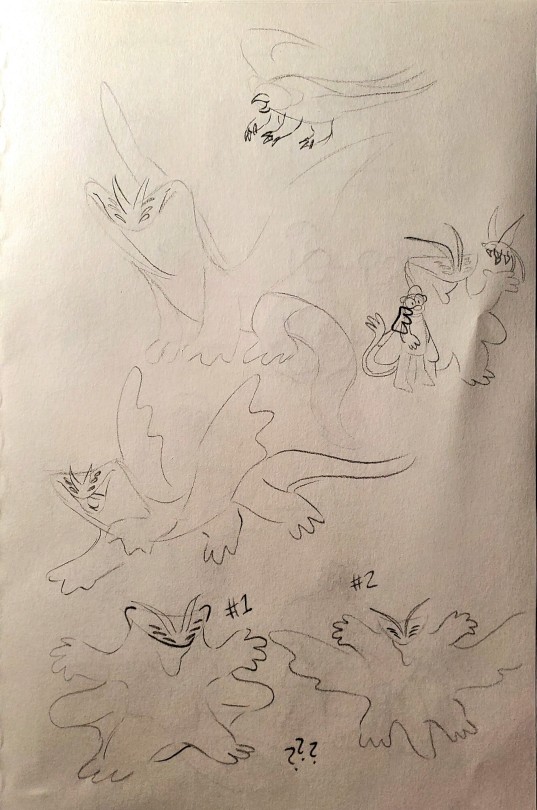

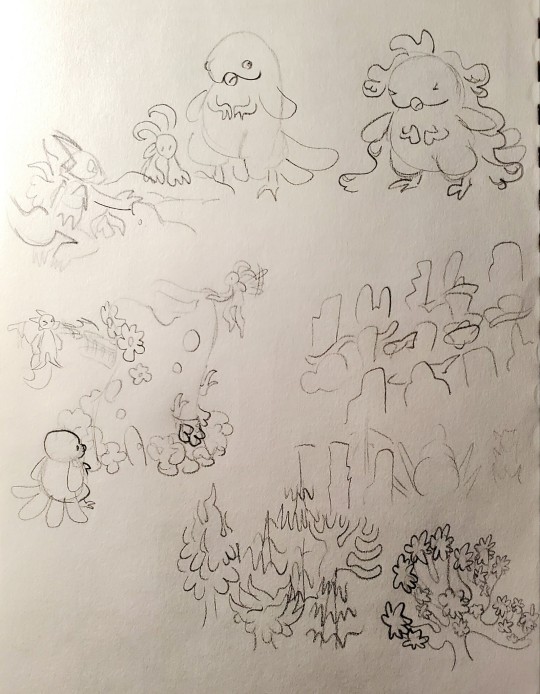
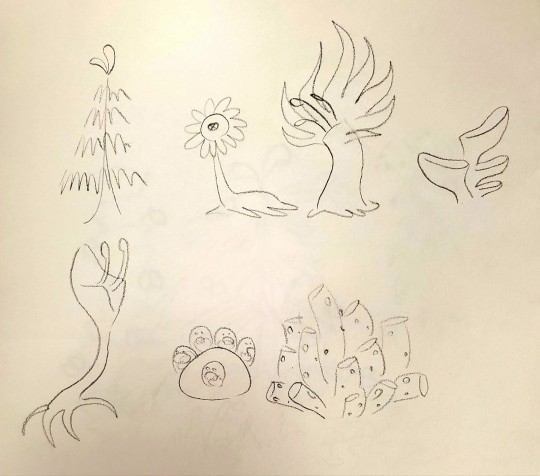
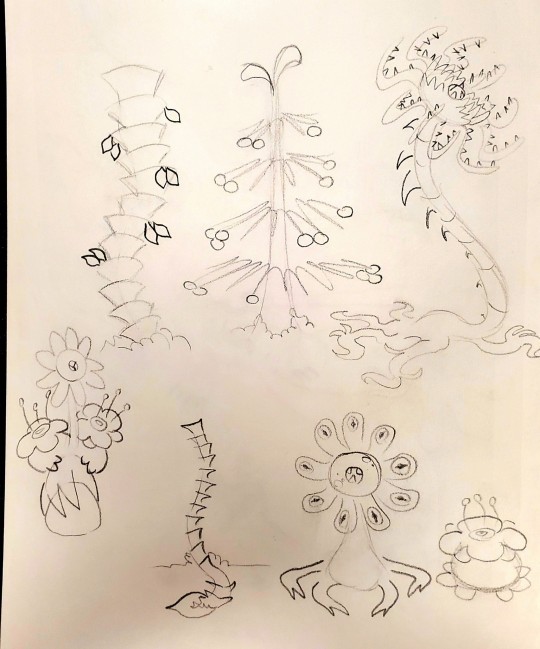
hello. I've been filling my assigned sketchbook with bright shadows development!
First pic is me playing around with the design of an earlier character named Kulakesa (previously "Kulagrester"), a Hancock's flatworm alien from kulupu telo who is married to a mayor. Because most of the people on Chonar have wings as their middle pair of limbs, I came up with a design of Kulakesa having big winglike fins for swimming. His flappy carpet body made the final cut however
the beaked critter swimming above is something i originally designed when i was in high school called a seagle. like sea eagle. not very original but they're marine snails filling the niches of different birds. not every snail in kulupu telo fills a bird niche however
flora and fungus in kulupu telo are taken up by different types of algae and sessile fauna. caulerpa-like grasses, oomycete toadstools, bryozoa bushes, and grape vine-shaped kelp. a weed resembling the mermaid's wineglass was cultivated and bred to be used as Actual wineglasses. the toadstools are safe to eat and frequently foraged for!
a new idea i had for kulupu telo at one point was like. Giant diatom biomes. like super shiny glossy beaches full of huge algal forests covered in glass. the sand and big diatoms are harvested for food, plankton, and glass
third picture is of some kulupu telo civilians building a house, alongside roughs of how tall buildings would look in kulupu telo. my original idea for an underwater world on chonar was for the buildings to be these tall pillars on top of each other that you could just swim through. I think I was inspired by... southside reef from shark tale. kulupu telo is now on the back of a continent-sized sea monster, so i switched it to amorphous houses made of mucus, sand, algae, bones, shells, etc all tightly packed so they can withstand the currents of the sea and little movements of soweli ma (the sea monster they live on top of)
not every house on kulupu telo contains these exact materials, and sometimes the use of these materials depends on cultural significance of the building. kulupu telo architecture is still wip wip wip wip wip
sessile invertebrates fill the niche of trees. the "fruit" on the worm trees are its eggs. They're based on earthworm egg cocoons and feel/taste like silkworm pupae. sometimes they're cracked open for the stuff inside like a bird egg and sometimes the whole thing is cooked like a legume. sea lily and anemone-like organisms act like BIIIGGG flowers that get both energy from food and the sun! i imagine if the big sea lilies were all in a field they would sometimes get up n migrate to spots where there r more critters to eat. ppl who want these as houseplants simply put them on a rock near a window and the lily and/or anemone can take in light and act as pest control
#art#my art#artists on tumblr#kulakesa (oc)#wete (oc)#kulupu telo#bright shadows#oc talk#speculative biology#speculative evolution#creature design#character design#original character#original characters#worldbuilding#sketch
11 notes
·
View notes
Text
okey dokey!!! my little object (?) world is still in development but i really should share it with you all... (especially @mumpsetc so i'm tagging you!!) here's a little blurb on botanica!!!!
so this is a peaceful planet filled with sentient fruit! yay!! if you'd like to learn more, read below :D

in botanica, as fruit ripen on their plants, the plant material grows inside of the fruit, as if a miniature version of the plant has grown into it - botanican fruit possess a circulatory system of xylem and phloem within their flesh, with stems and vines growing out to form appendages (fig 1). all botanicans have leaves on at least one appendage, which they use to photosynthesize. aside from this energy from the sun, botanicans also drink water, which is taken in with a root tongue, and consume soil, from which nutrients and moisture are absorbed in a stomach-like organ. in doing so, botanicans effectively keep themselves "fresh" and/or "ripe", meaning that the life of a botanican fruit off of the parent plant is longer than that of a corresponding fruit in our world. all botanicans do eventually pass, and when they do, their bodies decompose and the seeds within them have the chance of growing into plants that will create more botanicans.
botanicans, like our fruit, come in different species, but those species are grouped into four categories: roaming botanicans, which are vine fruits (melons, tomatoes, squash, grapes), coasting botanicans, which are tropical fruits (bananas, papayas, pineapples, starfruit), floating botanicans, which are berries (raspberries, strawberries, blueberries, blackberries), and soaring botanicans, which are tree fruit (apples, pears, peaches, cherries). citrus fruits are in a subcategory between coasting and soaring botanicans. (all of these category names are subject to change though!!)

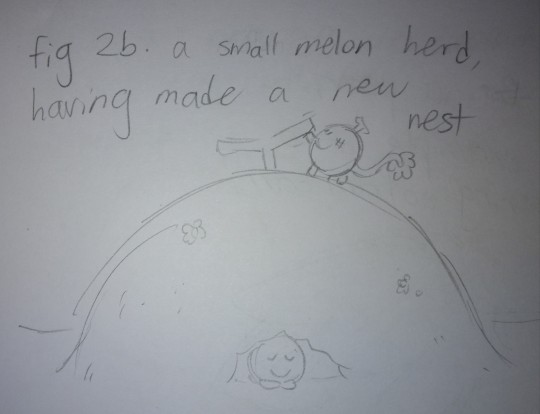
roaming botanicans are quadrupedal (four vine legs) with a prehensile vine-and-leaf tail (fig 2a); they live in sibling herds (usually small, but can vary in size) and roam around the landscape, without any designated leader among them. most roaming botanican species follow the sun year-round, and so avoid winter; in their constant migration they periodically stop to rest at hills, under which they burrow to make a nest. after making a nest under a hill, a herd will stick a branch at its peak so, after they leave, other herds will know that that hill can be used as a nesting site (fig 2b). some roaming botanicans have evolved to have particularly thick rinds, and so are more cold-resistant, and so opt not to constantly migrate, instead living more sedentary lives with occasional migration.
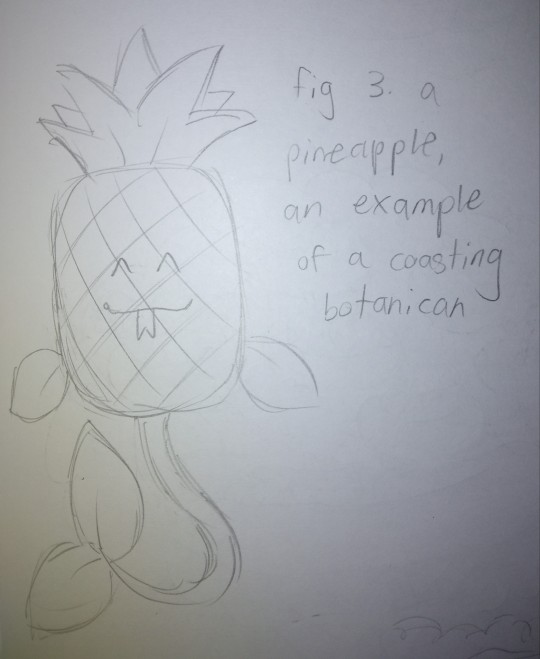
coasting botanicans have a stem-and-leaf tail and two leaf fins (fig 3); they grow on land but live the majority of their lives in the water, where they spend their time in groups. these groups are more based on friendship ties than familial ties, considering how vast a domain these botanicans have (basically the entire aquatic realm). more so than others, coasting botanicans connect with botanicans of other species and categories, and spend most of their lives just exploring and meeting others. while usually surrounded by others, a coasting botanican might on a rare chance find themselves alone in the ocean, in which case the loneliness will cause them to act in a way abnormal for most of their category - they will become antisocial and will lose their desire to explore. there are few cases of this occurring, however, given how populated and lively most corners of botanica's waters are.
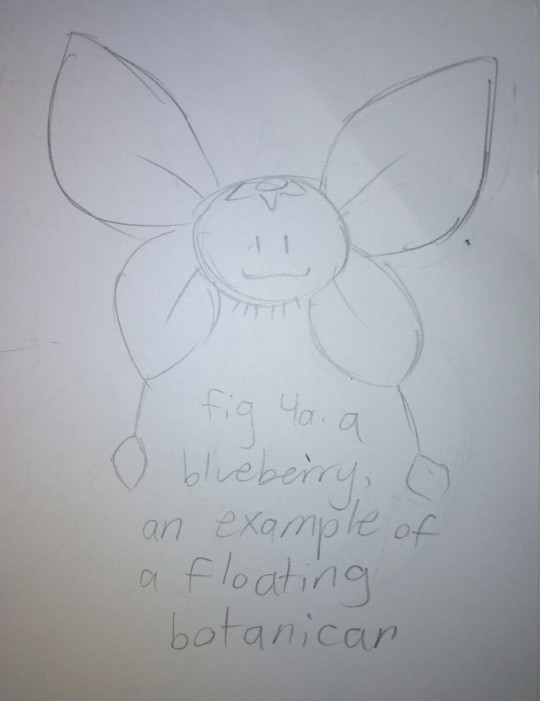
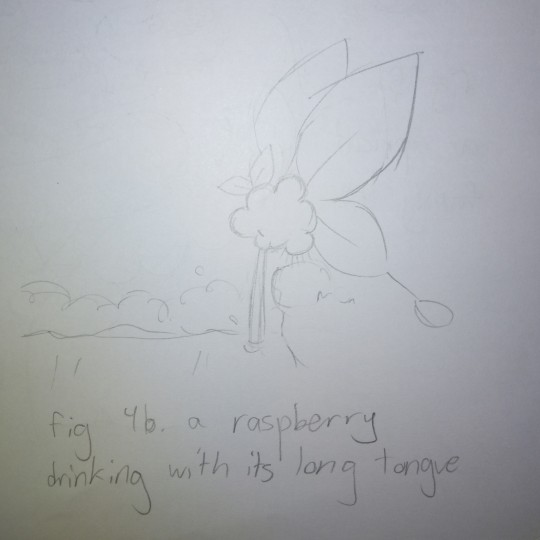
floating botanicans have four large leafy wings and six tiny stem feet (fig 4a); they are the most solitary of the four categories, being very individualized. they have a very strong connection to flowers, which they in fact pollinate - many cultivate their own gardens and end up specializing in a specific type of flower. floating botanicans can be very social at times, and often come together to form collaborative gardens and even breed flowers, but they do not live in groups. these botanicans, being so much smaller than the others, can often not safely drink out of rivers or lakes without falling in, and so have evolved a long root tongue to drink with (fig 4b).


soaring botanicans have two large, leafy wings and two stem talons (fig 5a); they tend to live in very large familial flocks, as fruit trees often produce mass amounts of botanicans. the first to ripen is usually the leader of the flock. these botanicans build nests in their family tree (get it?) using fallen sticks, branches, and other plant materials, which becomes the center of life (fig 5b). within a flock of soaring botanicans, many individuals are designated to explore the surrounding area for interesting additions to the nests (such as a foreign flower or a pretty rock). due to the large size of these groups, most individuals within a flock form a "twin" bond with another individual, which they spend more time with than others.

i don't think i ever came up with a name for the soaring-coasting subcategory, but in any event, these botanicans have a single broad leaf tail and two stem talons (fig 6). these botanicans are more closely related to soaring botanicans than coasting botanicans, but as they tend to live in more watery areas, they have many similarities to coasting botanicans and do not have the capability of flight. botanicans of this category live in large flocks in ponds, lakes, and rivers; many build small dams. unlike those of the typical flock of soaring botanicans, individuals within flocks of these botanicans tend to intermix more; they often make friends between flocks and so there seems to be some kind of broad botanican network from pond to pond, river to river, lake to lake. these botanicans, like coasting botanicans, are very friendly and carefree.
botanica is a peaceful, happy planet; basically every resource needed for survival is in abundance and there is no opportunity for greed and selfishness to even arise, so individuals are more often than not cooperative, kind, and generous. of course, as loss and loneliness are truths of life, no botanican life is free of all suffering altogether, and issues can arise - but given the warm, compassionate nature of the surrounding physical and social environments, individuals end up living happy, loving lives overall.

something interesting about botanican life is the complete disconnect between reproduction and relationhips - seeds are only spread after a botanican passes away, and those seeds grow into plants otherwise entirely disconnected from the botanican in question; then those plants are pollinated and new botanicans grow from them. in this way, botanicans have no real concept of sex, and often fall in love with and befriend members of different species (as there is no reason why this would be an issue; they wouldn't be reproducing with them anyway) (fig 7). while plant individuals sometimes have parts of a specific sex, most have parts of both sexes, and either way this has no impact on the mindset or behavior of the botanican as a whole creature (they technically have biological sex but they have no gender).
...so yeah, here's my silly fruit world!!! there's a lot of stuff left to talk about (with the gods of the world and everything) but this is good to start with :) i hope you like it!!!!
#dandy's doodles#botanica#osc#<- i never know if this really counts but i guess it does#this whole thing was very first created like 5 years before i even learned about the existence of object shows#but y'know there's a connection here#the reason why i love object shows so much is because i already personified inanimate objects!!#so yeah i guess this counts :)
46 notes
·
View notes
Note
hey!! you follow my plantblr (unexpectedplantblr) and i’ve learned so much just off your tags dude. wdym pruning omg i’m so wildly unprepared how and when should i be doing that! i can’t imagine they have yt videos on shit THAT basic do they!?.
and my apples are dwarfs?? i’ve been stressing abt them so close to the house and was trying to find an arborist to help me move them but do you think they’ll be ok with just some root guard? omg i’m so sorry to bug you feel free to ignore!
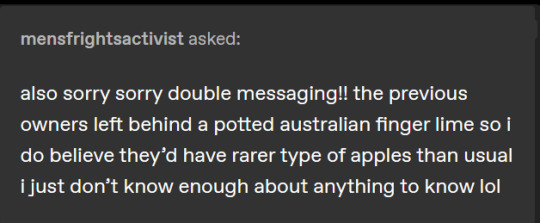
There’s no issues and I welcome the asks! This enthusiasm gives me old tumblr days vibes that I think many miss these days lol.
Inevitably most domestic fruiting woody plants need a trim up of pruning for maintenance. Some types don’t need it overall or don’t need it at certain life stages, but those are the lucky cases.
While I’m currently still in the midst of pruning season as of writing this, your photos imply it’s a smidgen late for you to be doing any at all unless it’s either for major issues or dead/diseased wood; it’s generally best to get the pruning before said woody plants leaf out but while they are still dormant to reduce shock, to avoid damaging freshly sprouted growth (since if you’re early enough there’s no leaves to worry about), and keep them wasting energy on wood that’ll be cut off in the process. I recall I got my info on pruning mostly by book literature but I wouldn’t be surprised if there’s some niche videos on the topic online- there are yt video journals and tutorials for niche fruits like Asimina triloba cultivation/maintenance so surely less exotic stuff would have online tutorials on it. Do try to find more than one source to try to average out the answers they give lest they give different answers or overlook different details (gardening can get subjective sometimes after all). If I recall the rule for Grape vines you try to keep one “lead vine” intact to be the one to produce new yearly branches/shoots that will then produce the grapes.
Fortunately I think you don’t have to worry about any issues with skipping the livewood pruning this year; let this year just help you get more familiar with what you’re dealing with.
For next year I can at least say from my own experience a few points; universally you want to prune to remove dead, damaged, and diseased wood, as well as any branches that crisscross with each other (since those will just make damaged wood from rubbing if allowed to stay), and generally you try to not cut more than a 3rd of the live growth (even if it means you gotta wait next year to fully shape a tree if the pruning work for some reason is major- which is my case with my older unkempt trees) to avoid having the pruning reach deadly amounts (there are exceptions- most Clematis are pruned to extreme amounts most of the time, well established Grapes and Kiwis can have a lot taken off too in certain cases). Oh and big one that newbies can miss; if you're getting tools, try to get bypass type pruning tools, anvil type pruning tools do damage to live wood (since they crush moreso to cut unlike bypass) and are better for exclusively dead/removed wood.
Observe what others do to their trees of similar kind to your own; I learned a little bit on what to do with my own apple trees from seeing what other people have done to their apple trees of similar size in my region.
It’s not easy at first but set goals for what you’re pruning. In my case a good chunk of my apple trees are quite old (we’re talking hollowed-out old for many of these trees), so my goal is generally to help extend their lives as well as fruit production as a bonus, so I try to reduce the sources of major weight burden on the large crumbling branches. Another goal in my case is making it that the branches are not as high up so that they are easier to maintain and harvest from, since yet again, my trees are on the larger/older end of what to expect from an orchard.
While not an option for me consulting Arborists is definitely not a bad option if you’re free to throw the cash.
Pruning rules/goals for your dwarf apple trees will probably be slightly different from what I do for my own trees since you’re dealing with very different growth forms from my own.
I am not 100% certain your apple trees by the house are dwarves but their growth habit feels more like what I’d expect/imagine from dwarf/semidwarf trees; as to what fruit variety it could be a lot of possibilities; apple trees tend to be grafted onto rootstock that affects their hardiness/size, so you could have similar cultivars to what I have for the fruit/scionwood but would definitely have very different cultivars for the rootstock that they are attached to. If the previous owners knew what they were doing they would’ve chosen dwarf roostock cultivars to avoid them becoming troublesome so close to the house.
In my opinion dwarves or not they are a bit big already to risk moving/transplanting away from the house without a painful and risky amount of long (worst case possibly years worth) of aftercare; if that is or was truly an issue you’d be better off getting new rootstock to plant in the new locations and grafting onto them from the house specimens onto those new rootstocks (you can hire/ask experts if you can’t quite do it yourself, we had a family member of a family member help save a heritage cultivar in our orchard by getting some successful grafts from the dying tree. I plan to do some grafting myself down the road I just dk what to graft rn). I am not familiar with root guard, from what I read it's a brand of fertilizer that claims to help stimulate root growth???
Also note with the Cherry/Plum trees mention before; one of the issues for ID sometimes for them is there’s just, a lot of species, a lot hybridize together, and that’s not even considering/factoring in domestic hybrids/cultivars where the diversity can be as wide as it is for apple cultivars. It can really muddy the waters for identification down to the exact kind unless you’re dealing with a very sharp specialist or a very distinct variety, and even then some may struggle with certain cases.
Lucky you to also have something as fancy as a finger lime! I already guessed so but that definitely solidified my guess that you are in a warmer growing zone from me lol.
#plantblr#ask#askbox#tried to break it apart to make it easier to read but dear lord that's a lotta text#wall of text
6 notes
·
View notes
Text
Napa Valley Pollution
Napa Valley, California, is home to over 1,800 wineries, representing 0.4% of the world’s wine grape production. While it pales in comparison to the largest vineyard in the world at 105,000 hectares, Napa Valley still has 18,667 hectares involved in cultivation.
It produces about 49.7 million cases of wine annually and has an estimated 34 billion dollar impact on the U.S. economy.
So why is it at risk?
The Pollution
The vineyards and wineries of Napa Valley are facing a pollution problem.
The Clover Flat Landfill (CFL) opened in 1963 to accept various local waste. It still takes in many types of waste like propane tanks, couches, and ovens, with a fee for certain kinds. The CFL is reportedly now able to recycle 50% of what it takes in. Its website also states that it currently operates at net zero emissions, meaning it makes up for the carbon emissions that it produces. It does, in fact, capture the methane gas that it produces to recycle it into electricity.
Pollution is more than just carbon dioxide, though.
Irresponsibly reported contamination and hazards at the CFL have come to light in recent months. One example is the misreported impact of the 2020 Glass Fire in California. While management of the CFL (the Pestoni family, at the time) claimed minimal impact, surfaced emails reveal that the measures to restrict erosion, eliminate sedimentation release, and manage storm water attenuation were completely destroyed. The article detailing this and other allegations, including the referenced emails, is linked here.
The CFL is to the north of Napa Valley and near two tributaries that flow to Napa River. This landfill is the primary source of the pollution the valley is facing. Increasing amounts of evidence indicate that the CFL has polluted these waterways with toxins from waste.
These toxins include chemicals and metals, such as nitrates, chromium, arsenic, iron, and zinc.
The Effects
Chromium and arsenic are potently toxic on their own, but the other pollutants listed are also very harmful if high amounts are in contact with or consumed by humans.
While studies and officials report that the waterways around Napa Valley are considered polluted, little is reported about how this might affect wine production. Many vineyards and wineries in Napa Valley refused to comment on the situation.
Waters polluted with heavy metals and chemicals can cause food to become contaminated, but the specific nature of grape cultivation and its water demands make these impacts difficult to report on.
We do know that recreation has been significantly impacted. People who fish and canoe in the Napa River have expressed concerns, and the California Sportfishing Protection Alliance even sued the CFL in 2022 for violations of the Water Pollution Control Act. In 2023, the CFL agreed to implement new erosion control measures, test stormwater, and train employees to improve pollution control.
Landfill pollution affects life in the waterways, decreasing aquatic life presence and leading to unknown results of long-term stream pollution.
Investigations into the CFL’s continued practices are ongoing. Hopefully in time we will have more details for how pollution may have affected grape cultivation in Napa Valley.
Additional Resources
1.https://www.theguardian.com/environment/article/2024/jun/09/napa-valley-pollution-vineyards-wineries
2. https://napavintners.com/press/docs/napa_valley_fast_facts.pdf
3. https://uvds.com/clover-flat-resource-recovery-park/
4.https://www.pressdemocrat.com/article/napa/clover-flat-landfill-napa-contamination-pestoni-glass-fire/
#pollution#napa valley#winery#wine#environmental impact#article#research#resources#environment#waste#landfill#water pollution
2 notes
·
View notes
Text
MyLang days 4-8: Geography, Flora, Fauna
Alright! This post continues where I've left off doing @quothalinguist's conlang year challenge.
The next prompts up to today center around defining the space that my speakers live in. I purposefully didn't let myself go down a rabbit hole about the specifics and instead let it be painted with a wide brush to be made more specific later.
Geography
MyLang is spoken by the Fae in an abandoned House and the surrounding Yard, which divides the "world" into two major super regions.
There are other communities of animals like the mice have their own barrow, the owl lives in the attic, like a dragon, and there could be a city inside a fallen tree log, or in a big old tree in the yard.
The House has been long abandoned, with the owners having disappeared into myth and legend long before the first Fae passed through the Hedge. The house has a basement, a first floor, a second floor and an attic. It looks like an old Victorian style house.
The Yard is surrounded by a hedge on one side, a forest on the other, a stream in the forest, and a road or path. These are the limits of this "world", but there are obviously other communities and regions that have their own cultures and languages. The Yard is untamed and wild with thick brambles that create nearly pitch-black forests, a pond that stretches like a sea, grass jungles, huge old trees, and a few stumps and logs that are converted into cities.
I think the size of the region is a quarter acre or so. I'm not sure if that super matters.
The scope of the House and Yard is like a subcontinent-sized region, maybe as large as California or Western Europe with travel tending to be pretty lengthy depending on where you’re going. I don't think I want to create as many descendant families as are in California or Western Europe. This setting is also not that "hard" so the size of the region really is whatever makes a fun story.
Climate and Weather Patterns
The house is set in a temperate forest region, like Southern Oregon or the Northeast, but with an elevated fantasy element. There are four distinct seasons and each comes with its own magic quality. The main two climatic regions are divided between the Yard and the House.
Yard Climate
The Yard bears the full brunt of the seasons with cold winters, wet springs, hot summers, and chilly autumns.
House Climate
The House Climate varies depending on the level. The basement tends to be warm and humid because of the furnace there. The first floor is kept temperately warm year round, experiencing mild seasonal variation. The Second floor has more seasonal variety, being the furthest from the furnace.
Flora
There’s the typical flora that I would recognize, but there are also Fae-size crops and magical plants that are more important to note. They are:
A kind of small blue-silver sweet berry, maybe it has magical properties
Fungus cultivated in the basement
A grain or rice-like cereal that is used to bake into bread. Is this a normal-sized grain (ie huge to the Fae scale) or a smaller one that is to their scale, but it is a young type of grain or grass that they harvest.
Other food-source plants to notes:
Dandelion roots and flowers
Acorns, used for food and building materials
Grass Seeds
Grass
Fruit trees: Lemon, Apple
Berries like blueberry, blackberry, strawberry, grapes?
Non food source plants:
A fungus used for lighting
Varieties of a moss that can be woven into textiles
A kind of leaf that can be sewn with spider silk to make clothing
Wood, generally derived from sticks
Bark, used as a building material
Grass fibers that are used to create rope and other materials.
Fauna
Just some listed off the top of my head that would be relevant:
Mammals
Badger
Cat
Mouse
Rat
Vole
Mole
Insects
Bee
Beetles (probably tons of varieties, like riding beetles, beetles for food, etc.)
Ants
Termites
Centipede
Birds
Song Bird
Hawk
Screech Owl
Raven/Crow
I also had an idea that the root word for "sky" evolves to the word for "ceiling" in Housespeak.
3 notes
·
View notes
Text
Israeli and European archaeologists provide new insight into the mystery of ancient Gaza wine
By JUDY SIEGEL-ITZKOVICH
Published: APRIL 27, 2023 15:22
Grape pips (seeds) that were excavated from a Byzantine monastery in the Negev hint at the origins of the ‘mysterious’ Gaza wine and the history of grapevine cultivation in desert conditions. One of the seeds – probably from a white grape – has been dated to the 8th century and may be the earliest of its kind documented anywhere in the world.
It is thought it could be linked to the sweet white wine - the Gaza wine - that archaeologists have seen references to in historical records, but a lack of evidence of white varieties from the period has until now left uncertainty over its true origins. The wine was produced in the Negev and shipped across the Byzantine Empire, as well as to Germany, France, and Britain, where it is thought to have been enjoyed by royal households.
Researchers at Tel Aviv University (TAU) including Dr. Meirav Meiri of the Steinhardt Museum of Natural History and Israel National Center for Biodiversity Studies; the University of York (England); and the University of Copenhagen (Denmark) used genetic analyses to identify several different grape cultivars that were grown in Negev vineyards including both white and black grapes. Colleagues at the University of Haifa, Bar-Ilan University and the Israel Antiquities Authority collaborated in the study, which was published in the Proceedings of the [US] National Academy of Sciences under the title “New insight into the mystery of ancient Gaza wine.”
Identifying characteristics of ancient grape seeds
Dr. Nathan Wales from the University of York’s archaeology department commented that “this is the first time that genetics has been used to identify the color of an ancient grape and gives us a glimpse into the internationally famous Gaza wine during the period. It also gave us the opportunity to link ancient seeds with modern varieties that are still grown around the Mediterranean today.”
“The modern winemaking industry is heavily reliant on a limited number of European grape cultivars that are best suited for cultivation in temperate climates. Global warming emphasizes the need for diversity in this high-impact agricultural crop. Grapevine lineages bred in hot and arid regions, often preserved over centuries, may present an alternative to the classic winemaking grape cultivars,” the team wrote.

“Our study of a legacy grapevine variety from the Negev Highlands desert of southern Israel sheds light on its genetics, biological properties, and lasting impact.”
Since the domestication of the wild vine in Southwest Asia over 6,000 years ago, it is been primarily grown for wine. Viticulture (grape growing) and viniculture (winemaking) evolved along multiple historical pathways in diverse wine regions and produced a myriad of legacy cultivars, the team wrote.
Wales added that identifying the grape varieties that grew in the Negev during the Byzantine period and the genetic characteristics that were nurtured in these dry, desert conditions, could provide valuable insights into how plant varieties could be developed to resist the extremes of climate conditions today.”
The grapevines made some of the largest profits of any crop in Byzantine times and trade from Negev with Lebanon and Crete, for example, have sprung modern varieties of red wine that are still produced in these areas today. “Despite the Early Islamic (seventh to tenth centuries) and the Mamluk (13th century) enforcement of Muslim law that forbids wine production and consumption, vines continued to be cultivated for the local consumption of table grapes, raisins and, in limited amounts, ceremonial wine among Jews and Christians,” the team wrote. “However, knowledge of the specific grapevine cultivated in the Negev was lost.”
15 notes
·
View notes
Text
Sipping Perfection: Mount Towrong Winery — A Gem in Macedon Ranges, Australia

The Idyllic Setting:
Mount Towrong Winery is strategically located amidst the undulating hills and lush vineyards of Macedon Ranges. The serene atmosphere and cool climate provide the ideal conditions for cultivating high-quality grapes. Visitors are treated to sweeping views of the surrounding countryside, making it an idyllic escape from the hustle and bustle of city life. The vineyard’s commitment to sustainable practices further enhances its appeal, creating an eco-friendly haven for both wine lovers and nature enthusiasts.
A Rich History:
Founded in 1994, Mount Towrong Winery has a rich history deeply intertwined with the evolution of winemaking in the Macedon Ranges. The winery’s founders, George and Deirdre, were visionaries who recognized the region’s potential for producing exceptional cool-climate wines. Their dedication and passion laid the foundation for what is now considered the premier winery in the area.
The Terroir Advantage:
Mount Towrong Winery’s success is attributed to its unique terroir, characterized by cool temperatures, diverse soil types, and optimal elevation. These factors contribute to the distinctive flavors and aromas present in their wines. The vineyard carefully selects grape varieties that thrive in these conditions, resulting in a diverse range of wines that showcase the best of the Macedon Ranges terroir.
Signature Wines:
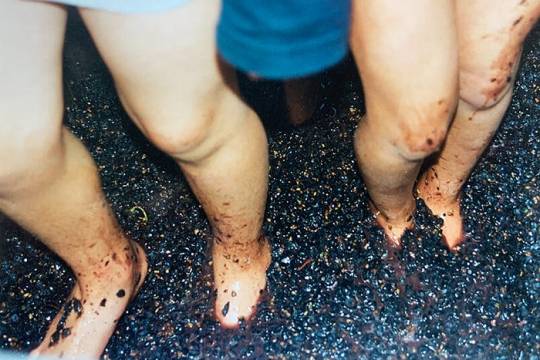
Awards and Recognition:
The accolades bestowed upon Mount Towrong Winery underscore its commitment to excellence. The winery has garnered numerous awards for its outstanding vintages, solidifying its status as a leader in Macedon Ranges’ winemaking. The dedication to quality and innovation is evident in every bottle, making Mount Towrong a name synonymous with exceptional wine.
Visit and Experience:
For those looking to experience the magic of Mount Towrong Winery firsthand, a visit to the cellar door is a must. The welcoming ambiance, coupled with knowledgeable staff, ensures a memorable tasting experience. Additionally, the winery often hosts events, including vineyard tours, blending sessions, and seasonal celebrations, providing visitors with a deeper understanding of the winemaking process.
Conclusion:
Mount Towrong Winery stands tall as the epitome of winemaking excellence in the Macedon Ranges. Its captivating setting, rich history, and exceptional wines make it a destination that transcends the ordinary. Whether you’re a seasoned wine connoisseur or a casual enthusiast, a visit to Mount Towrong promises an unforgettable journey into the heart of Australian winemaking perfection.
#australian wine#winery mount macedon#macedon ranges winery lunch#vineyard#winelover#winery#fine wine#white wine#wine#wineglass
2 notes
·
View notes
Text
Horticulture definition & Branches
Horticulture is a subfield of agriculture that focuses on the cultivation, management, and study of plants used for non-food purposes like medicine or industry. It also includes non-food crops like flowers and ornamental plants. In order to produce high-quality and profitable crops for a variety of uses, including food production, landscaping, ornamental adornment, and more, it involves a wide range of plant-related operations, including planting, breeding, irrigating, growing, harvesting, and post-harvest processing. Horticulture is a broad field that includes everything from modest backyard gardens to extensive commercial operations, and it frequently entails the use of specialized knowledge and techniques to improve the growth and development of plants.
Enhancing the quality, quantity, nutritional value, and aesthetic appeal of plants—whether they are cultivated for food, medicine, ornamentation, or other purposes—is the aim of horticulture. To maximize the growing conditions and productivity of plants, horticulturists use a variety of procedures, including breeding, grafting, pruning, and pest management.
Pomology: This branch of horticulture is concerned with the cultivation of fruits. Pomologists study the production, storage, processing, and marketing of fruit crops such as apples, citrus fruits, grapes, and berries.
Olericulture: Olericulture is the branch of horticulture that deals with the production and cultivation of vegetables. It includes the study of vegetables from seed production to harvesting, storage, and marketing. Common vegetables studied in olericulture include tomatoes, lettuce, carrots, and onions.
Floriculture: Floriculture focuses on the cultivation of flowering and ornamental plants for their aesthetic and decorative qualities. This branch includes the production of flowers, cut foliage, potted plants, and landscaping materials. Floriculturists often work in the floral and landscaping industries.
Viticulture: Viticulture involves the cultivation of grapes for wine, raisins, and table grapes. This branch covers various aspects of grape production, including vineyard management, pest control, and the study of grape varieties suitable for different purposes.
Oenology: While not strictly a branch of horticulture, oenology is closely related as it involves the study of wine and winemaking. Oenologists focus on fermentation processes, wine chemistry, and sensory evaluation to produce high-quality wines.
Pest Management: This branch is concerned with the study of pests that affect horticultural crops and the development of strategies to manage and control these pests. Integrated Pest Management (IPM) is an approach that combines biological, cultural, physical, and chemical control methods to minimize the impact of pests on crops.
Post-Harvest Physiology and Technology: This branch deals with the handling, storage, transportation, and processing of horticultural crops after harvest. It aims to maintain the quality and freshness of produce from the farm to the consumer.
Urban horticulture: This field of study focuses on the special difficulties and opportunities associated with cultivating plants in urban settings. In order to improve urban green spaces, it includes endeavors like rooftop gardening, vertical gardening, and community gardening.
Seed Science and Technology: Seed science involves the study of seeds, including their development, germination, storage, and viability. Seed technologists focus on the development of high-quality seeds for improved crop production.
Turf Management: Turf management is concerned with the cultivation and maintenance of grasses for lawns, sports fields, and other recreational areas. It involves aspects such as mowing, fertilization, pest control, and irrigation.
These different types of horticulture demonstrate the diversity of plant-related activities and the important role they play in providing food, beautifying landscapes, supporting the economy, and contributing to human well-being. Horticultural practices continue to evolve with advances in science and technology, contributing to improved crop yields, sustainability, and overall quality of plant products.
Kindly visit for more - https://krishilearning.com/branch-of-horticulture/
What you"ll discover here -
Educational Resources - Our blog serves as a treasure trove of educational content, including articles and lesson plans, all designed to enhance your understanding of agricultural principles, practices and new technology in agriculture. We explore cutting-edge technologies, such as hydroponics, aquaponics, precision farming, and more, to help you stay ahead in the ever-evolving world of agriculture.
We have designed our website to be user-friendly, making it easy for you to navigate, access, and engage with our content. We value your user experience.
Join Us in Cultivating Knowledge
Whether you are a farmer, a student, a teacher, or simply someone interested in the world of agriculture, krishilearning is here to guide you on your educational journey. Together, we can foster a more sustainable, innovative, and prosperous agricultural sector. Join us in cultivating knowledge, growing communities, and embracing the future of agriculture.
2 notes
·
View notes
Text
Is Prosecco a champagne or wine?
When it comes to the world of bubbly beverages, the terms "Champagne," "wine," and "Prosecco" often appear interchangeably, causing confusion among enthusiasts. While all three are associated with celebrations and special occasions, there are significant differences that set them apart. In this article, we will delve into the world of sparkling wines, specifically exploring the distinction between Champagne, Prosecco, and other types of wine.
Understanding Champagne and Wine
Champagne, a variety of sparkling wines, has its origins in the Champagne region of France. It is known for its distinctive effervescence, elegant flavors, and association with luxury. Champagne is produced using a traditional method called méthode champenoise, where secondary fermentation takes place in the bottle. This labor-intensive process contributes to the complexity and quality of Champagne. The Champagne region, with its unique terroir, including soil composition and climate, plays a crucial role in the production of these exquisite wines.
Wine, on the other hand, is a broad category that encompasses a wide range of alcoholic beverages made from fermented grapes. It includes still wines, which are non-effervescent, as well as sparkling wines, which possess varying levels of carbonation. Unlike Champagne, which refers specifically to sparkling wine from the Champagne region, wine can be produced in numerous regions worldwide, each with its own distinctive characteristics.
Prosecco: The Sparkling Wine
Prosecco is a type of sparkling wine that hails from the Veneto region in northeastern Italy. It has gained popularity in recent years due to its approachable and lively nature. Unlike Champagne, Prosecco undergoes a different production process known as the Charmat method. This technique involves conducting the secondary fermentation in a large tank rather than in individual bottles. It results in a fresher, fruitier style of sparkling wine, often characterized by notes of green apple, pear, and citrus.
The primary grape used in Prosecco production is Glera, which contributes to its light and delicate flavor profile. The Prosecco region, encompassing Conegliano and Valdobbiadene, benefits from the region's microclimate, ideal for cultivating grapes that yield high-quality Prosecco. Prosecco is typically enjoyed young and is often associated with casual gatherings, brunches, and outdoor celebrations.
Exploring Sparkling Wine
Sparkling wine is a broader category that encompasses a diverse range of effervescent wines from various regions worldwide. It includes not only Champagne and Prosecco but also other sparkling wines such as Cava from Spain, Crémant from France, and sparkling wines produced in the New World. Sparkling wine is characterized by its carbonation, achieved through different production methods like the traditional method, Charmat method, and carbonation.
Sparkling wine has seen a surge in popularity, with consumers embracing its festive and celebratory nature. It offers a wide spectrum of styles, ranging from bone-dry to sweet, and from light-bodied to full-bodied. This versatility makes sparkling wine a fantastic choice for a range of occasions, from toasting milestones to pairing with various cuisines.

The Best Sparkling Wines
When it comes to the best sparkling wines, there are numerous options available to suit different palates and preferences. Champagne remains synonymous with luxury and is often the go-to choice for special celebrations. Some renowned Champagne houses, such as Moët & Chandon, Veuve Clicquot, and Dom Pérignon, consistently produce exceptional sparkling wines that embody elegance and finesse.
However, there are also outstanding sparkling wines produced outside of the Champagne region. Crémant, for example, offers an affordable alternative to Champagne, with notable regions like Crémant de Bourgogne and Crémant d'Alsace producing high-quality sparkling wines. Additionally, sparkling wines from regions like Franciacorta in Italy and Sussex in England have been garnering acclaim for their unique expressions.
The Rise of Rosé Sparkling Wine
One of the significant trends in the world of sparkling wine is the increasing popularity of rosé sparkling wine. Rosé sparkling wines combine the vibrant and refreshing characteristics of sparkling wines with the delicate fruitiness of rosé wines. They are produced using various methods, including blending red and white wines, maceration, or the saignée method.
Rosé sparkling wines offer a wide range of flavors, from light and crisp to rich and complex, making them incredibly versatile for food pairings. They have become a favorite choice for many wine enthusiasts, as they provide a beautiful balance between elegance and approachability. Regions like Champagne, Provence, and the United States have been producing exceptional rosé sparkling wines that continue to captivate consumers.
The Fine Wine Company Ltd and Sparkling Wines
The Fine Wine Company Ltd is renowned for its collection of premium wines from around the world. Among their impressive selection, sparkling wines hold a prominent place. They offer an array of options for enthusiasts seeking the perfect bottle of bubbly for any occasion. From prestigious Champagne houses to exceptional Prosecco producers, The Fine Wine Company Ltd curates a range of sparkling wines to cater to diverse tastes and preferences.
For those seeking the best sparkling wines, The Fine Wine Company Ltd's knowledgeable staff can provide recommendations based on individual preferences, budget, and occasion. Whether it's a crisp and elegant Champagne, a lively Prosecco, or an exquisite sparkling rosé, customers can find a premium selection at The Fine Wine Company Ltd to enhance their celebrations or simply indulge in a glass of effervescent delight.
Conclusion
In conclusion, while the terms "Champagne," "Prosecco," and "wine" are often used interchangeably, they represent distinct categories within the realm of sparkling beverages. Champagne holds a prestigious status as a sparkling wine originating exclusively from the Champagne region in France, produced using the méthode champenoise. Prosecco, on the other hand, is a sparkling wine from the Veneto region in Italy, crafted using the Charmat method, resulting in a fresh and fruity character.
At The Fine Wine Company Ltd, enthusiasts can explore a diverse selection of premium sparkling wines, including Champagne, Prosecco, and other notable sparkling wine varieties. With their expertise, customers can discover the perfect bottle to elevate their celebrations, indulging in the effervescence and elegance that sparkling wines bring to any occasion.
3 notes
·
View notes
Text

Bold what your muse likes !
( repost, don’t reblog! )
Taste: Sweet | Salty | Bitter | Umami | Sour | Chocolate | Bacon | Vegetables | Fruit | Berries | Carrots | Cake | Cookies | Pretzels | Pasta | Tomatoes* | Applesauce | Sauerkraut | Pickles | Olives | Potatoes | Ice Cream | Pineapple | Pineapple on pizza | Fish | Beef | Garlic | Spinach | Mushrooms | Cheese | Spelt Bread | Milk | Juice | Marmite | Beetroot | Anchovies | Gefilte Fish | Peppers | Whole wheat bread | Marshmallows | Mango | Broccoli | Peanut butter | Nutella | Mint and Chocolate | Cashew nuts | Tofu | Brussels sprouts | Grape | Chicken Wolf first ate Tomatoes at the spider Society and was from that moment on hooked: Tomatoesoup with herbs and fresh bread, Cherrytomatoes as a little snack, tomatoes with sheepcheese, oliveoil and basillicum, Tomatoepesto, still warm Foccacia with tomatoes, oregano and olives, sundried tomates as a snack... Wolf is a very simple person and if one wants a favour from her its easy to pay her back by just inviting her for a hot tomatoesoup with herbs, fresh bread and if one really wants to make her heart sing like a little bird, some cream as a treat. She is very sad that she will never be able to eat tomatoes in her world and time as it would be not only hundreds of years until tomatoes would be brought to europe but even more time for the kind of tomatoes she loves eating to be cultivated and grown. It makes her rather depressed so if she has the chance, she will indulge in her massive cravings of tomatoes without holding back.
Touch: Soft | Rough | Smooth | Sticky | Slimy | Hot | Cold | Damp | Wet | Clammy | Coarse | Fur | Velvet | Silk | Lace | Hot metal | Cold metal | Paper | Plastic | Bubble wrap | Wool | Wood | Tree bark | Hot asphalt | Leaves | Wicker | Sand | Rocks | Rough rocks | Smooth rocks | Hair | Skin | Tight hugs | Gentle hugs | Lip kisses | Skin kisses | Holding hands | Rough touches | Gentle touches | Scratches | Bites | Sunlight | Light sheets | Thick blankets | Baggy clothes | Dried petals Due to the poxscars on her hands, Wolf is in general very icky when it comes to touching things with her bare hands as the scars easily can start to ache. This happens especially when what she is touching is cold.
Scent: Flowers | Sea water | Chocolate | Fish | Cooking onions | Cleaning products | Citrus | Lemons | Grapefruit | Oranges | Vinegar | Rain | Freshly cut grass | Wet dirt | Wood | Cologne | Perfume | Fire | Smoke | Gasoline | Tires | Paint | Chlorine | Pools | Fresh bread | Cooking bacon | New books | Coffee | Linen | Vanilla | Cinnamon | New car | Coconut | Sunscreen | Nail polish | Mint | Cigarette smoke | Leather
Sound: Loud sounds | High pitched sounds | Low pitched sounds | Quiet sounds | Loud voices | Soft voices | High voices | Deep voices | Morning voice | Snoring | Rain on windows | Fire crackle | Crickets | Frogs | Typing on a keyboard | Horse hooves on gravel | High heels | Laughter | Deep laughter | Giggling | Purring | Dog bark | Howling | Car engine | Distant chatter | Bird chirps | Classical music | Pop music | Folk music | Rock music |Country music | Klezmer music | Violin | Piano | Frying food | Nails tapping Wolf beeing prone to migraines makes her very sensetive to sounds.That her senses had been increased by her mutation is in this manner not helping at all. She will flinch when she is screamed or yelled at and high pitched sounds will be able to trigger a migraine attack. When she is overstimulated or when she wants to go to sleep, Wolf usually stuffs her ears with wax.
Sight: Red | Orange | Yellow | Green | Blue | Purple | Pink | Black | White | Silver | Gold | Shiny | Dull | Shapes | Orange lighting | Natural lighting | Seaside scenery | Forest scenery | Field scenery | Patterns | Clear skies | Cloudy skies | Night time | Day time | Sunrise | Sunset | Stain glass windows | Old buildings | Stone buildings | Wood cabins | Spring | Summer | Fall | Winter | Brick buildings | Moss | Flowers | Gardens | Hedge mazes |Corn mazes | Lakes | Rivers
Tagged By: Walter von der Vogelweide Tagging: @alchemaxed @spinxeret @iobartach @goblinfire @wovendeath @sickthem @voltedblood @carnivorousfatality @the-rogue-dragon @h-osborn @books-and-right-hooks @kylo-wrecked @canoncompliance !
3 notes
·
View notes
Note
For the writers ask meme: 1, 2, 17, 35
1 - Do you know how you want the story to end when you start, or are you just stumbling through the figurative wilderness hoping to find a road?
I usually know how stories will end, but not necessarily where, if that makes sense. There have been exceptions in both cases, but usually I have some idea of how the central crisis will be resolved and general emotional beats I want the ending to have, but not exactly what that's going to look like. The former gives me something specific to work towards and lends emotional coherence to the work as a whole, but even when I'm working towards a particular ending scene, I don't always have a totally clear picture of it.
Like, I knew "Several Witches Are Typing" would end with the team getting back to Willow's house and her dads discovering them, but hadn't necessarily fleshed out everything beyond that when I started the story. Sometimes I'll even have really specific details pinned down but be missing another big, important chunk (by the time I actually started writing "Aurum Horizontale" I knew Keyleth was going to give Percy the friendship bracelet made from the fragments of his exploded gun, but wasn't entirely sure if Percy was going to leave with Vox Machina or not -- an uncertainty that I ultimately realized he would have himself, so I dug into that).
I don't like having nothing though. The stories I don't have a clear ending for are also, not coincidentally often the stories that end up abandoned. Every time I think my excitement at the start is enough to propel me through, I end up being wrong.
On the flip side, the stories I do have endings in mind for are the ones I hang onto for years and years, and am confident I have a shot at actually finishing even when I've taken long hiatuses. I know exactly how "I Breathed a Song Into the Air" is going to end, as well as the transgender Marty McFly WIP I've had in my drafts for ages. I also have a pretty solid idea of the ending of my trans Caleb Wittebane fic ("Go Down to the Netherworld, Plant Grapes) and the TOH Sherlock Holmes pastiche that I haven't even officially started writing yet. And I'm working on defining the ending to the longer of my two Pentiment WIPs ("Beharren ist Eine Kunst") for exactly this reason, so hopefully that can lend anyone interested in those stories some hope even if my updates are uh, inconsistent.
2 - Talk about a notable time a narrative or character has looked you dead in the eyes and said “fuck your plan, here’s what we’re actually doing.”
Usually this happens because they've decided to make the story longer (or I've misjudged how long a scene would actually be...)
Unfortunately the best example I had of this was a fic I'm still contemplating ways to rework -- I had a oneshot I was working on mid-S2/S3 TOH hiatus that collided with another idea of mine and had the potential to be a really interesting, long story, but ultimately hit me during something of a writing slump, and the show restarted before I got much of it written. I'd love to at least clean up the original oneshot into something postable one day, but would have to scrap a lot of my favorite parts of the longer story now since I don't think it can be repurposed into something I like.
Alas. It was a really cool thing to have happen (writing two things at once and realizing there was enough fascinating thematic overlap to turn it into a single story if I played my cards right) and I hope someday it happens with a fic I can actually get off the ground.
17 - What is your favorite line you’ve ever written?
A more recent example, but I'm awfully fond of this one from my Pentiment exchange fic, "Long Upon the Land" (Paul, my boy Paul)
It wasn’t fair, and the older he grew, the more he found the gentleness and piety he’d always tried to cultivate tested by the bitter serpent that had curled itself around his heart, whispering that one day he ought to spit back “Fathers, provoke not your children to indignation, lest they be discouraged,” with a less-than-righteous venom the next time he was told obedience was a virtue.
35 - Tell us about a character who’s very different than you who you love a whole lot
A recent one, but I am extremely fond of Magdalene Druckeryn, even as someone who is a lot more like Andreas myself. She's so incredibly stubborn and plucky, an a lovely example of how to do female protagonists in historical fiction that are constrained by the position of women in society but don't let themselves be completely limited by it (and, have lovely and encouraging relationships with other women of the same time period instead of falling prey to the idea that "interesting" historical women have to be an exception). The game gave her such incredibly demanding shoes to fill as an Act III protagonist and she does so wonderfully. I lack her particular brand of snark and courage -- my own looks quite different -- but I love her, and I'm loving having a fic project where I get to write her, too.
3 notes
·
View notes